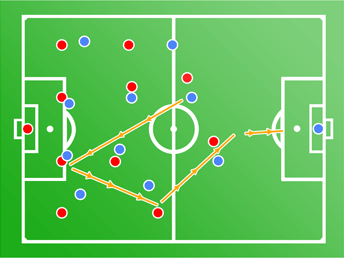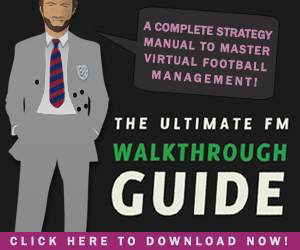-
Recent Articles
3 at the back and the 4-4-2 Diamond
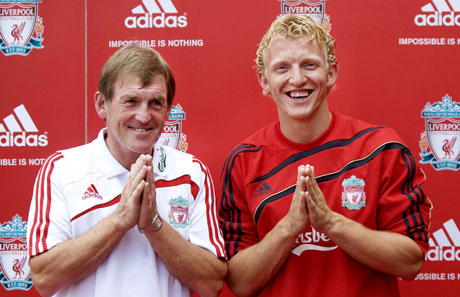 Last week Chelsea v Liverpool became the biggest tactical talking point of the season. Liverpool revived the the 3 man defence that Kenny debuted against Stoke. While with the introduction of Torres for £50m...
Last week Chelsea v Liverpool became the biggest tactical talking point of the season. Liverpool revived the the 3 man defence that Kenny debuted against Stoke. While with the introduction of Torres for £50m...How To Set Up A Back Four
 Last year, I wrote a guide about how to play a simple 4-4-2. One of the major components of that is the back four. In fact, most modern formations build upon four defenders; two full backs and two centre...
Last year, I wrote a guide about how to play a simple 4-4-2. One of the major components of that is the back four. In fact, most modern formations build upon four defenders; two full backs and two centre...Building Your Defence: Full Backs
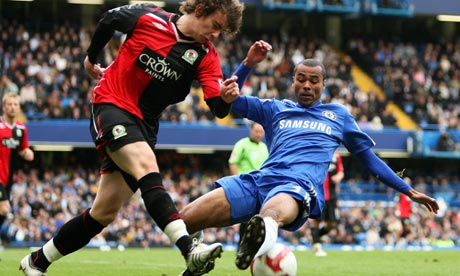 The modern full back is quickly becoming one of the most important players on the team sheet, infact even back in the days of Brian Clough, fat ed' argued that because of the space these players get in the final...
The modern full back is quickly becoming one of the most important players on the team sheet, infact even back in the days of Brian Clough, fat ed' argued that because of the space these players get in the final...False Nine Tactics
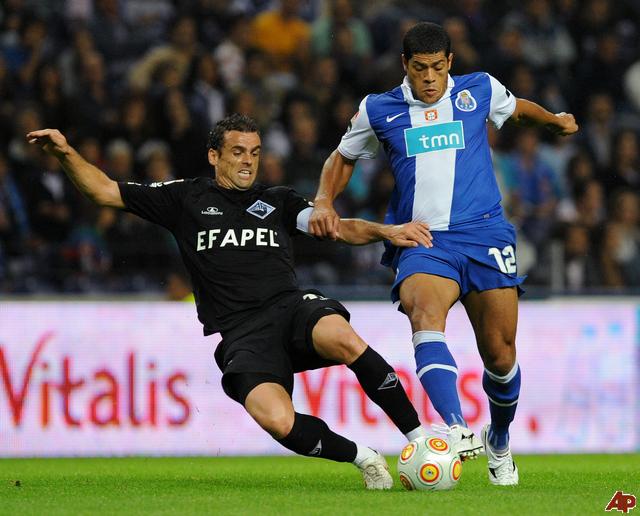 When we think about modern football trends, we think about the fall of the 4-4-2, the introduction of inverted wingers and the rise of the 4-5-1. But there is one other tactical rise that seems to have...
When we think about modern football trends, we think about the fall of the 4-4-2, the introduction of inverted wingers and the rise of the 4-5-1. But there is one other tactical rise that seems to have...An Open Letter To The Football Manager Community
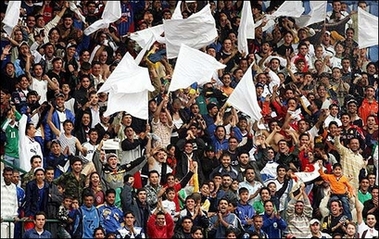 To view Sports Interactive's response, click here FM-Britain will no longer be producing regular content. Sports Interactive have objected to our content model of charging for annual strategy guides,...
To view Sports Interactive's response, click here FM-Britain will no longer be producing regular content. Sports Interactive have objected to our content model of charging for annual strategy guides,...
JOIN 11,611 READERS - SUBSCRIBE NOW TO OUR FOOTBALL MANAGER NEWSLETTER
Get the latest FM news & best community content delivered directly to your e-mail inbox!
Tactical Bible ’08: Tactic Tweaking I
Written by: Matt vom Brocke
Category: In-Match
Posted on: June 16, 2007
June 16, 2007
Tweaking I
Helpful tweaks for fine-tuning tactics
The tweaking articles are simple collections of small topics that cover several settings and ideas that may help you to fine tune your tactics. These little ideas can be very helpful and, if implemented right, boost the success of your tactics immensely.
Contents
Forward runs
Optimising Foul Ratios
Semi-playmaker and semi-targetmen
Counter attack
Matchday: exploiting weaknesses of the opposition, avoiding own weaknesses
Power of Forward Runs
Forward runs have become even more powerful in FM 07. In previous versions, many tactic designers could not live without massive use of forward and backward arrows. They are still helpful for achieving certain tendencies of movement with or without ball, especially the long arrows on wingers. But since FM 07, forward runs should be the major tactic tweaking tool if you intend to alter the tactical behaviour of your squad in a massive way.
Forward runs result in a completely different tactical interpretation of the player’s role. E.g. a DMC with forward runs rarely will play as an anchorman, always supporting the back four and especially the DCs by staying in close range. A DMC with mixed forward runs will link up much strongly with the build up play and stay much further forward than the defensive line. A DMC with forward runs set to often will tend to act like a very deep lying playmaker.
Setting up the forward runs properly leads to real life setups in every area of your squad. It is crucial for establishing prolific partnerships like a MC/d and MC/a couple or a fast striker/strong striker combo.
You will notice these effects when playing many continental diamond teams or the classical defensive Capello-Real Madrid-4-2-2-2. Without altering the formation you will suddenly notice the ML/R and FBs crossing from your byline.
Altering the FWR settings should be your first measure to change things if a tactic does not work properly and if tweaking a home tactic into an away tactic, even before switching or supported by mentality changes.
Optimising Foul Ratios
Once your base tactic is roughly working, you should have a look at optimising your set pieces to gain many dead ball situations in the opposition half and to concede as few as possible in your own half.
If you have decent attacking players, RWB and HUB will result in numerous opposition fouls close to the penalty area. Holding up the ball with wingers or a fast striker can be used in certain offensive-minded tactics to control your attacking moves. Crosses from byline in an attacking formation can help to gain free kicks from dangerous positions. Crosses set to often don’t reach the penalty area in many cases, but often enough result in gaining a corner.
If you are using high closing down, you should set your players to easy tackling to avoid numerous fouls. If you team still commits too many fouls at dangerous spots, you should consider reducing your closing down a few notches to minimise these.
Semi-playmakers and semi-target men
Playmakers:
Player that you put into your playmaker box will be searched by their teammates more often, even if the playmaker option is not ticked.
This is a good way to introduce a certain preference of passing, without the obvious disadvantages of relying too heavily on a playmaker who might be marked out of the game or having a bad day. Several playmakers can be added to the list to achieve a more even distribution of the ball, but this will of course as well reduce the dominance of one player.
As with using full target men, you will have to monitor the way the ball is distributed in the team and if these settings are really helpful or create a one dimensional play by focussing the passing at the wrong areas of the pitch.
Target men:
The same can be applied to target men. The team even tends to use the set target men supply when you have selected players as target men, but unticked the target men option.
This is very helpful for keeping your attacking options open while enforcing a certain kind of play or when your target man is marked heavily and this results in losing momentum of your play.
Counter Attack
There are two ways to look at it: possession-wise or counter-chances-wise. If you intend to play a possession oriented game, you will certainly select counter attack as a defensive measure and only use it for close home games and for away games where you are less focussed on possession.
However, counter attack can be a strong attacking instrument if you are less focussed on possession and rather want to give up some possession points for creating quick chances on the counter. It is hard to say which approach works best, both have logical pro and contra arguments.
However, if you are facing ultra-timewasting sides, counter attack will not be a measure to break them down in most cases, unless you are lucky and score an early lead. In some cases, counter attack can work well with overloading tactics if you are using quick strikers who always have plenty passing options to their teammates.
So, if you are aiming at possession as first measure to win games, you should restrict counter attack to away games and very difficult home games, while you will implement high closing down settings throughout midfield and attack. If you are aiming at winning most of your games on the counter, you should reduce the closing down to give the opposition some space and fall down to quickly start and attack as soon as you won the ball back.
Match Day
Exploiting weak spots of the opposition
It can be helpful to look at you strikers’ opposition. If the opponents are using different defenders, e.g. small and tall, it can be helpful to play your quick striker against the tall but slow one and vice versa. These tweaks certainly can be helpful, if your tactic is not based on having a certain striker on a certain side. Alternately you could instruct your strikers to swap positions.
If you get a scout report telling you the opposition’s defence is on the slow side, you could look to play your fastest forwards and start with a tactic that uses run to ball TMS or switch your supply to run to ball.
If the report mentions a weakness when dealing with crosses, you could go the opposite route, play strong strikers, set supply to head and crosses to often for all wing players.
If the opposition strikers are no threat in the air, you could play with quick, small defenders and maybe play a higher line if needed.
Avoiding weak spots of your own team
Conversely there may be the same problem in your own defence: Your strong but slow defender has to cover an explosive forward, while the small quick one plays on the side of a strong target man. As long as the opposition does not swap positions, this can be easily solved at cost of your set piece optimisation.
If the opposition is swapping positions, it may be worth an effort to mark specific in such a game, but then you will have to monitor any formation changes of the opposition.
If you are playing on your back foot for 90 minutes, it will not make much sense to play fullbacks with 18 crossing and dribbling but 10 marking and tackling. Choose strong defenders then, especially if the opposition is good in the air.
Generally: if you expect being forced into a defensive game, you should look to choose players that have stronger defensive attributes, if you intend to attack vice versa.
Also it might be worth to look at you players’ character. If you know from scout reports and own experience that certain players love/hate big matches, you should take this into consideration when choosing your team for an important occasion.
Tactical Bible Credits
thegooner, wwfan, Millie, garyh, JP, The Next Diaby. Editor: Millie
About The Author: Matt vom Brocke
Matt’s contribution to FM-B as a whole and the tactical area in particular cannot be over-estimated. The writer of the very well-recieved Communication and Psychological Warfare and Creativo set of tactics, Matt is a key member of the Tactical Think Tank and part of SI’s beta testing Dream Team.
Download Our Tactical Theorems '10 eBook Absolutely Free

Presenting the most comprehensive tactic design and match strategy guide to the Football Manager series ever created!
Written by FM match engine beta testers, it's 60+ pages of easy-to-read concepts and ideologies for getting your team playing exactly how you want each match! It's been downloaded over 100,000+ times to date!
Find out more information about our tactical eBook
and download Tactical Theorems '10 right now!
Written by FM match engine beta testers, it's 60+ pages of easy-to-read concepts and ideologies for getting your team playing exactly how you want each match! It's been downloaded over 100,000+ times to date!
and download Tactical Theorems '10 right now!
Web discoveries
- UK Casinos Not On Gamstop
- Online Casinos UK
- Best Slot Sites
- Non Gamstop Casinos
- Casino Sites Not On Gamstop
- UK Online Casinos Not On Gamstop
- Slots Not On Gamstop
- Non Gamstop Casino UK
- Non Gamstop Casino UK
- Casino Sites Not On Gamstop
- UK Online Casinos Not On Gamstop
- Casinos Not On Gamstop
- Gambling Sites Not On Gamstop
- Non Gamstop Casinos
- Non Gamstop Casinos
- Non Gamstop Casino UK
- UK Casino Not On Gamstop
- Casino Sites Not On Gamstop
- UK Online Casinos Not On Gamstop
- UK Online Casinos Not On Gamstop
- Brand New Casinos Not Blocked By Gamstop


